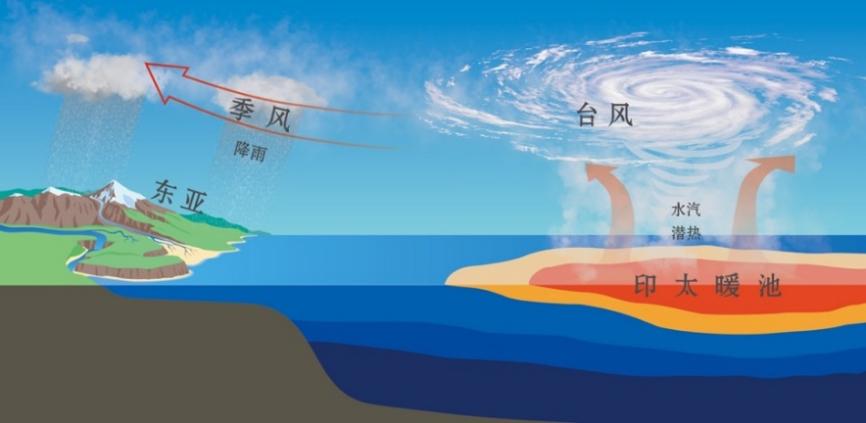一、气候系统水/热传输的海洋隧道和大气桥梁
Oceanic Tunnel & Atmospheric Bridge of Water/Heat Transport in the Earth’s Climate System
海洋是地球气候系统储热能力最大的圈层,也是大气湿静力能的主要来源,海洋热量变化是全球气候系统的一个核心变量,对气候演变有重要影响。工业革命以来,人为温室效应造成全球变暖,其中90%以上的过剩热量进入了海洋。现代观测研究表明,作为主要的能量源区,包括温跃层在内的上层海洋是驱动或影响台风、季风等大气环流运动的关键所在。热带东印度洋-西太平洋暖池是全球表层海温最高、热含量最集中的区域,不断地为大气上升运动、对流降雨提供能量和水汽,也是整个地球气候系统的“热量和蒸汽引擎”。
2022年,我室“三维空间古海洋学”团队,以“海洋热含量演变及其气候效应”为主题,从不同时间尺度出发,探讨了地球海气耦合系统中能量储存和输送的特征及规律,为未来全球变暖背景下地球能量分配和流动提供了重要启示。
海洋热量-陆地降雨的能量学联系
Jian et al. (2022) 首次综合利用暖池区10个深海沉积岩芯的微体化石样品,同时提取浮游有孔虫表层种G. ruber和温跃层种P. obliquiloculata的壳体Mg/Ca比值,分别建立了表层海温和温跃层海温的综合曲线,计算了过去36万年以来(0至200米)上层海水热含量(OHC)的变化,发现暖池OHC重建记录与地球气候系统数值模式瞬变模拟的OHC变化非常一致。同时,暖池OHC变化与暖池区表层海水剩余氧同位素(δ18Osw)以及中国石笋记录的大气降雨氧同位素,在2万年岁差周期上的变化一致,反映出暖池OHC增大,表层海水δ18Osw变重、石笋氧同位素变轻的岁差周期变化规律。这说明在长时间尺度的天文周期上,暖池的热量变化可以调控太平洋与亚洲大陆之间的水汽传输,即暖池热量增加,海表蒸发增强、水汽汇聚并以季风和台风的形式向相邻陆地传输,导致东亚降雨增加。

暖池热含量、以及海-陆间氧同位素“跷跷板”的重建(彩色线)和模拟(黑色线)

海-陆间水循环的氧同位素分馏示意图(a)及数值模拟结果(b-c)
本研究发现暖池OHC的变化,由2万年岁差周期主导,同时也表现出较弱的4万年斜率周期,这些周期特征反映了低纬海区太阳辐射量经向梯度驱动上层海洋温跃层环流圈的主控作用,即经向海洋热量传输的“海洋隧道”效应。另一方面,暖池OHC与东亚降雨在岁差周期上的一致变化,说明暖池热含量变化能够发挥类似“水塔”的作用,调控海洋水汽的蒸发辐合、海-陆之间的水汽传输及与之相伴的水汽潜热的传输和释放,代表了低纬驱动水、热传输的“大气桥梁”效应。

热带太平洋上层海洋热量的“水塔”效应,与东亚季风区降雨紧密联系
总之,这项研究综合利用现代观测、古环境替代指标、以及海气耦合模式和水同位素数值模式的瞬变模拟,发现了热带海洋变暖对东亚季风气候的强化作用,首次从能量学角度揭示了海洋内部热量变化是决定海洋水汽和潜热运移及其向陆地输送的最关键因素,为解答海-陆水热循环联系提供了最新见解。
从热带太平洋到北极海冰的海气联系
暖池区上层海洋热含量是热带太平洋ENSO的核心特征,暖池热含量增加,对应热带东太平洋海表温度偏冷(即La Niña状态);而暖池热含量减少,对应东太平洋海表温度偏暖(即El Niño状态)。当前的全球变暖背景下,热带太平洋年际尺度ENSO事件的频次显著增加且似以El Niño事件增加为主。El Niño增强会导致冬春季节热带东太平洋海表温度异常变暖、大气Walker环流减弱,引发太平洋-北美格局(Pacific-North America pattern,PNA)的正相位事件,表现为北美区域的西风急流弯曲程度比较大、北极涡旋稳定性减小、北美热穹、寒潮等极端天气和灾害事件也容易发生。
近3年来我室刘忠方团队开展系列研究,揭示出全球变暖驱动的ENSO和PNA长期趋势对北极夏季海冰加速消融的驱动作用。相对于夏季海冰,学术界和社会公众对北极冬季海冰的关注普遍较少。卫星观测显示,北极冬季海冰自2005年开始迅速减少,特别是在巴伦支海—喀拉海(BKS)地区,其减少速率几乎与夏季相当,贡献了超过1/3的北极冬季海冰变化,成为整个北极冬季消融最快、增温最强的热点区域。
北极冬季海冰消融的主因,究竟是海洋还是大气过程?针对这一问题,Liu et al. (2022) 利用卫星观测、海洋与大气再分析数据及数值模拟,验证了在全球变暖背景下,年际尺度的PNA正相位事件逐渐增强,相关的中低纬度大气强迫主导了北极冬季海冰消融。具体来讲,北半球冬季,PNA正相位会引发北极欧亚海盆的反气旋(顺时针)大气环流持续增强,增加该地区的热量和水汽输送,导致表层气温和向下的长波辐射增加,加速海冰消融。在未来变暖背景下,该反气旋环流将会持续增强,进一步加剧北极海冰消融。与此同时,来自北大西洋的海洋暖流向巴伦支-喀拉海区的传输增强,贡献了另外一半的海冰消融所需热量。总括起来,正PNA事件所激发的北极大气反气旋环流、以及北大西洋海洋暖流构成了中-高纬度区水、热传输的“大气桥梁”和“海洋隧道”。


观测与模拟的巴伦支-喀拉海冬季海冰对大气环流的响应
该项研究首先厘清了大气与海洋过程对冬季海冰消融的相对贡献,以及海冰消融与大气环流的因果关系;如进一步与中-低纬度区的全球季风环流、海洋温跃层环流相联系,则可能深刻揭示不同外部驱动条件下赤道和极地之间的能量平衡和气候耦合。
主要参考文献:
Jian, Z., Wang, Y., Dang, H., Mohtadi, M., Rosenthal, Y., Lea, D.W., Liu, Z., Jin, H., Ye, L., Kuhnt, W., Wang, X. (2022). Warm pool ocean heat content regulates ocean–continent moisture transport. Nature, 612: 92-99.
Liu, Z, Risi, C., Codron, F., Jian, Z., Wei, Z., He, X., Poulsen, C.J., Wang, Y., Chen, D., Ma, W., Cheng, Y., Bowen, G.J. (2022). Atmospheric forcing dominates winter Barents-Kara sea ice variability on interannual to decadal time scales. Proceedings of the National Academy of Sciences (PNAS), 119(36): e2120770119.
The ocean has the largest heat storage capacity, serving as a main source of atmospheric moist static energy, with the ocean heat content (OHC) a core variable of the Earth’s climate system. The Indo-Pacific warm pool (IPWP) with the largest body of warm upper-ocean waters, known as the "heat and steam engine" of the climate system, plays a key role in the transport of heat and water vapor from the ocean interior to the monsoonal continent and also the higher latitudes.
Prof. Zhimin Jian and Prof. Zhongfang Liu, leading the “Three-dimensional paleoceanography” team, have been working on the variations and mechanisms of the storage and transport of energy in Earth’s sea-air coupled system on various time-scales. In the year 2022, they published one Article in Nature, entitled “Warm pool ocean heat content regulates ocean–continent moisture transport”, and one paper in PNAS, entitled “Atmospheric forcing dominates winter Barents-Kara sea ice variability on interannual to decadal time scales”, which may provide crucial clues for understanding the energy distribution and flux in the Earth’s surface system under the current global warming.
The Nature Article (Jian et al., 2022) combined modern observations, paleo-proxy records, and transient simulations of air-sea coupled and water-isotope models, to investigate the history and effects of the OHC over the past 360,000 years. The warm pool OHC varies with a dominant 23,000-year precession cycle and a weaker 41,000-year obliquity cycle, reflecting the modulation mechanisms of the low-latitude meridional gradient of solar radiation on the upper ocean heat distribution, through the “oceanic tunnel” of subtropical-tropical thermocline circulation. Further, the change of warm pool heat content and related ENSO dynamics can play a role as a “water tower”, via the “atmospheric bridge” effect of the water vapor transport and latent heat release, in regulating the ocean-to-land water and heat cycles between the tropical Pacific and the monsoonal East Asia. These results, for the first time, reveals the critical impact of ocean interior heat changes on determining the sea-land hydroclimatic cycles, and provides key energetic insights into the hypothesis of “Low-latitude Forcing of Climate Evolution”.
The PNAS paper (Liu et al., 2022) investigated the accelerated melting of Arctic (to be specific, the Barents-Kara Sea, BKS) winter sea ice under global warming, which had drawn less attention than the melting of summer sea ice, and been viewed as a combined response to oceanic and atmospheric processes. In short, this study discovered that the positive Pacific-North America (PNA) events can stimulate the Arctic atmospheric anticyclonic circulation anomalies, resulting in more atmospheric heat and moisture transported into the BKS region and enhanced downward longwave radiation, and finally contribute more than half to the ocean warming and sea ice decline. Beside the “ocean tunnel” role of North Atlantic warm current, the importance of atmospheric processes for Arctic winter sea ice variability is reinforced and the “atmospheric bridge” in the water and heat transport through the low- to mid-high latitudes are disentangled, providing key evidence for understanding the climate within and beyond the Arctic.

